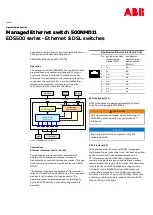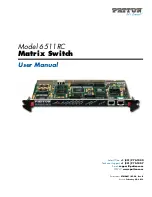
DGS-1250 Series Gigabit Ethernet Smart Managed Switch Web UI Reference Guide
89
802.1D-2004 Rapid Spanning Tree
The Switch implements three versions of the Spanning Tree Protocol, the Multiple Spanning Tree Protocol (MSTP) as
defined by IEEE 802.1Q-2005, the Rapid Spanning Tree Protocol (RSTP) as defined by IEEE 802.1D-2004 and a
version compatible with IEEE 802.1D-1998. RSTP can operate with legacy equipment implementing IEEE 802.1D-
1998; however, the advantages of using RSTP will be lost. This section introduces some new Spanning Tree concepts
and illustrates the main differences between the two protocols.
Port Transition States
An essential difference between the three protocols is in the way ports transition to a forwarding state and in the way,
this transition relates to the role of the port (forwarding or not forwarding) in the topology. MSTP and RSTP combine
the transition states Disabled, Blocking, and Listening used in 802.1D-1998 and creates a single state called
Discarding. In either case, ports do not forward packets. In the STP port, transition states Disabled, Blocking or
Listening or in the RSTP/MSTP port state Discarding, there is no functional difference, the port is not active in the
network topology. Table 7-3 below compares how the three protocols differ regarding the port state transition.
All three protocols calculate a stable topology in the same way. Every segment will have a single path to the root
bridge. All bridges listen for BPDU packets. However, BPDU packets are sent more frequently, with every Hello
packet. BPDU packets are sent even if a BPDU packet was not received. Therefore, each link between bridges is
sensitive to the status of the link. Ultimately, this difference results in faster detection of failed links, and therefore
faster topology adjustment. A drawback of IEEE 802.1D-1998 is this absence of immediate feedback from adjacent
bridges.
802.1Q-2005 MSTP
802.1D-2004 RSTP
802.1D-1998 STP
Forwarding
Learning
Disabled
Disabled
Disabled
No
No
Discarding
Discarding
Blocking
No
No
Discarding
Discarding
Listening
No
No
Learning
Learning
Learning
No
Yes
Forwarding
Forwarding
Forwarding
Yes
Yes
RSTP is capable of a more rapid transition to the Forwarding state. RSTP no longer relies on timer configurations and
RSTP-compliant bridges are sensitive to feedback from other RSTP-compliant bridge links. Ports do not need to wait
for the topology to stabilize before transitioning to a Forwarding state. In order to allow this rapid transition, the
protocol introduces two new variables: the Edge Port and the Point-to-Point (P2P) port.
Edge Port
A port can be configured as an Edge Port if it is directly connected to a segment where a loop cannot be created. An
example would be a port connected directly to a single workstation. Ports that are designated as edge ports transition
to a forwarding state immediately without going through the Listening and Learning states. An Edge Port loses its
status if it receives a BPDU packet, after which it immediately becomes a normal spanning tree port.
P2P Port
A P2P port is also capable of rapid transition. P2P ports may be used to connect to other bridges. Under RSTP/MSTP,
all ports operating in full-duplex mode are considered to be P2P ports unless manually overridden through
configuration.
802.1D-1998/802.1D-2004/802.1Q-2005 Compatibility
MSTP or RSTP can interoperate with legacy equipment and are capable of automatically adjusting BPDU packets to
802.1D-1998 format when necessary. However, any segment using 802.1D-1998 STP will not benefit from the rapid
transition and rapid topology change detection of MSTP or RSTP. The protocol also includes a variable used for
migration in the event that legacy equipment on a segment is updated to use RSTP or MSTP.
Содержание DGS-1250 Series
Страница 1: ......
















































